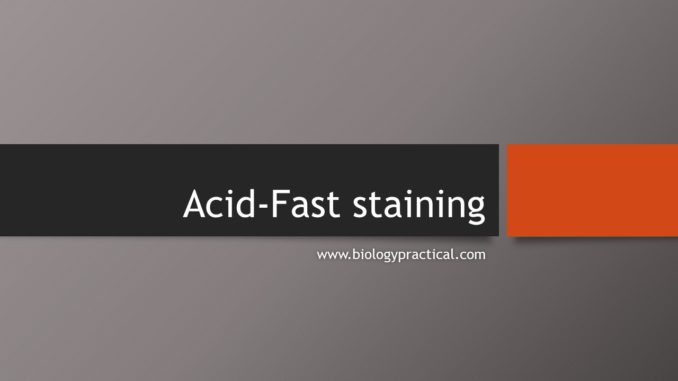
Acid-Fast staining (Ziehl-Neelsen technique):
Principle:
Acid fast staining is a differential staining technique which differentiate acid fast and non-acid fast bacteria. Mycobacterium species contains large amount of mycolic acid in its cell wall. Due to high lipid content, most dyes cannot enter easily through the cell wall, so Mycobacterium species cannot be stained by Gram staining. A special staining method is developed to stain such organism called as Acid-fast staining method. It is also known as Ziehl-Neelsen method.
In this method, bacteria is stained with carbol fuchsin combined with phenol. The stain binds to the mycolic acid in the mycobacterial cell wall. After staining, an acid alcohol is applied as decolorizing agent which removes the stain from the background cells, tissue fibres, and any organisms in the smear except mycobacteria which retain (hold fast to) the dye and are therefore referred to as acid fast bacilli, or simply AFB. After decolorization, the smear is counter stained with malachite green or methylene blue which stains the background material green or blue, providing a contrast colour against which the red AFB can be seen.
Note: Some Actinomycetes, Corynebacteria, and bacterial endospores are also acid fast.
The acid-fast stain uses three different reagents.
1.Primary Stain (Carbol Fuchsin): Unlike cells that are easily stained by ordinary aqueous stains, most species of mycobacteria are not stainable with common dyes such as methylene blue and crystal violet. Carbol fuchsin, a dark red stain in 5% phenol that is soluble in the lipoidal materials that constitute most of the mycobacterial cell wall, does penetrate these bacteria and is retained. Penetration is further enhanced by the application of heat, which drives the carbol fuchsin through the lipoidal wall and into the cytoplasm. This application of heat is used in the Ziehl-Neelsen method. The Kinyoun method, a modification of the Ziehl-Neelsen method, circumvents the use of heat by addition of a wetting agent (Tergitol) to this stain, which reduces surface tension between the cell wall of the mycobacteria and the stain. After primary staining, all cells will appear red.
2. Decolorizing Agent (Acid-Alcohol; 3% HCl + 95% Ethanol): Prior to decolorization, the smear is cooled, which allows the mycolic acid to solidify such that AFB will be resistant to decolorization. Primary stain is more soluble in the cellular waxes than in the decolorizing agent. So, in this event, the primary stain is retained and the mycobacteria will stay red while non-acid fast bacteria become decolorized (colourless).
3. Counterstain (Methylene Blue or malachite green): This is used as the final reagent to stain previously decolorized cells. As only non–acid-fast cells undergo decolorization, they may now absorb the counterstain and take on its blue color or green, while acid-fast cells retain the red of the primary stain.
Requirements:
- Fresh culture sample: 72-96 hour trypticase soya broth culture of Mycobacterium smegmatis/24-hour agar culture of Staphylococcus epidermidis
- Primary stain: carbol fuchsin
- Decolorizing agent: acid alcohol (3% HCl +95% ethanol)
- Counter stain: methylene blue/ malachite green
- Bunsen burner
- Inoculating loop
- Microscope
- Distilled water
- Soft cotton or tissue paper
- Microscopic Slides
- China-marking pencil or permanent marking pen
Procedure
Procedure for Smear preparation
- Take a clean glass slide.
- Using aseptic technique, prepare a smear of given sample organisms
- Heat-fix the dried smear
- Alcohol-fixation: This is recommended when the smear has not been prepared from sodium hypochlorite (bleach) treated sputum and will not be stained immediately. M. tuberculosisis killed by bleach and during the staining process. Heat-fixation of untreated sputum will not kill M. tuberculosis whereas alcohol-fixation is bactericidal.
Procedure for Acid-fast staining
- Flood the smear with carbol fuchsin stain.
- Heat the stain until vapour just begins to rise (i.e. about 60C). Do not allow stain to evaporate; replenish stain as needed. Also, prevent stain from boiling. Do not overheat. Allow the heated stain to remain on the slide for 5 minutes.
- * For a COLD METHOD, flood the smear with carbol fuchsin containing Tergitol for 5 to 10 minutes.
- Wash off the stain with clean distilled water. Heated slides must be cooled prior to washing
- Decolorize the smear with 3% v/v acid alcohol for 5 minutes or until the smear is sufficiently decolorized, i.e. pale pink by adding the reagent drop by drop until the alcohol runs almost clear with a slight red tinge.
- Wash well with clean water.
- Flood the smear with malachite green or methylene blue stain for 1–2 minutes.
- Wash off the stain with clean water.
- Wipe the back of the slide clean, and place it in a draining rack for the smear to air-dry (do not blot dry).
- Examine the smear microscopically, using the 100X oil immersion objective.
- Scan the smear systematically.
- Note: Do not touch the smear with the end of the oil dispenser because this could transfer AFB from one preparation to another.
- After examining a positive smear, the oil must be wiped from the objective.
References
- Cappuccino, J.G and Welsh C. Microbiology: a laboratory manual (2018). Pearson education limited, England. 11 edition.
- Manandhar S, Sharma S (2006): practical approach to microbiology, Graphic plus printers, Kathmandu
- Shah P.K, Dahal P.R, Amatya J (2009): Practical microbiology, Delta offset press, Thapathali, Kathmandu
